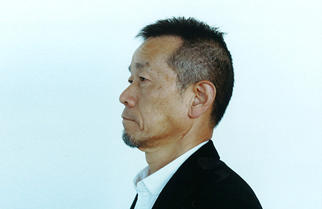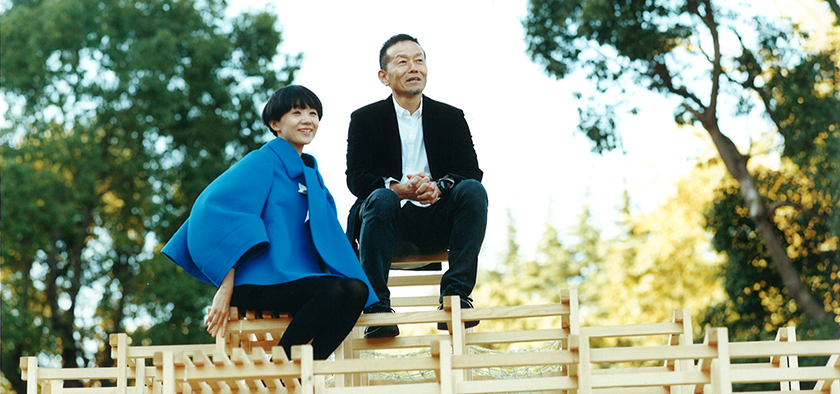
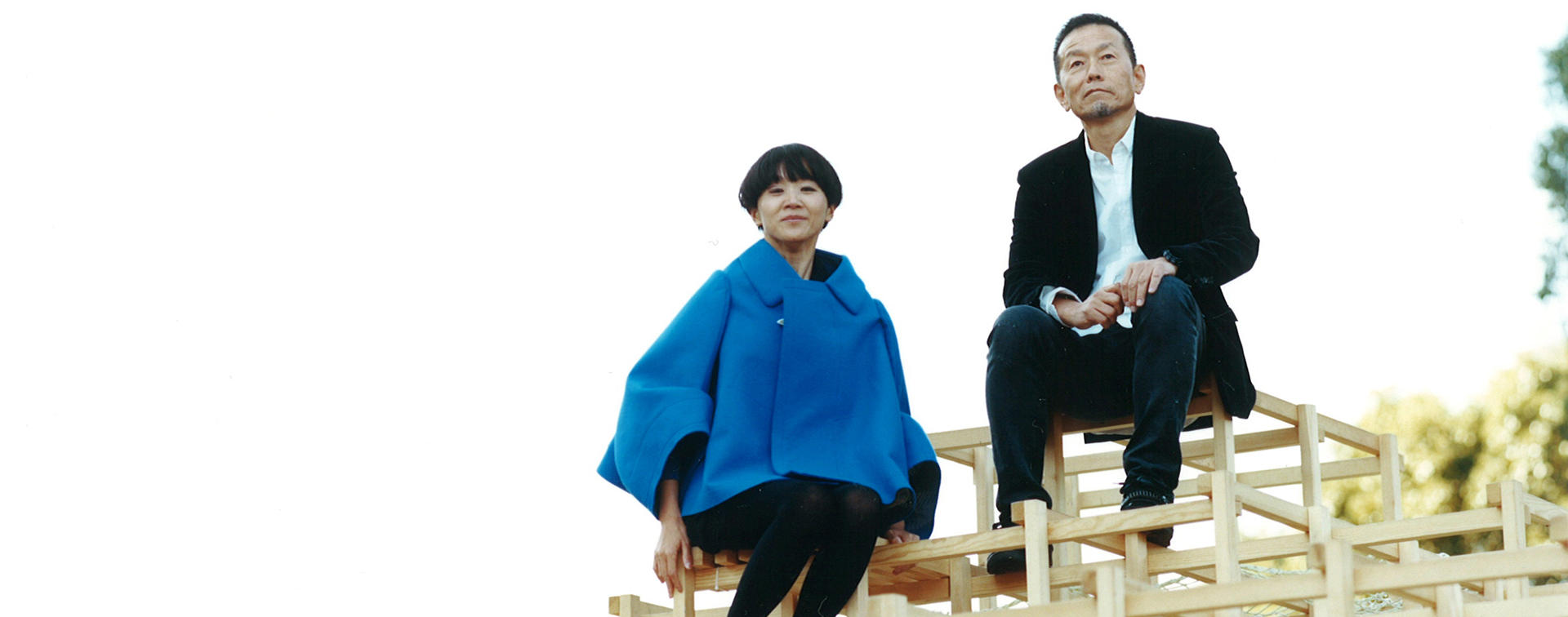
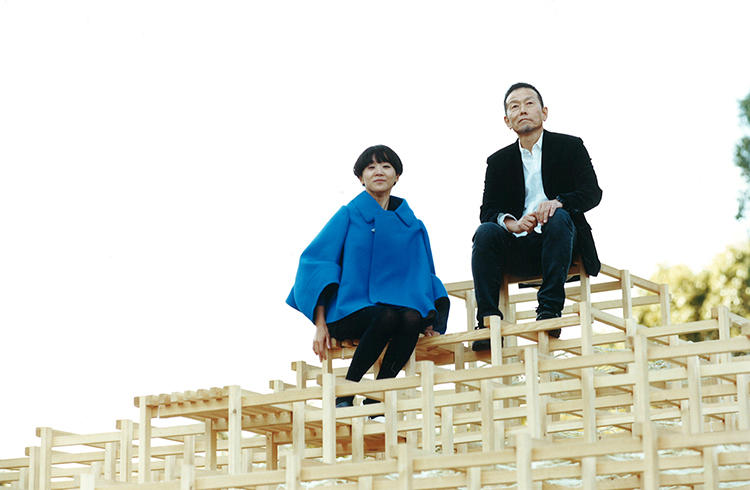
How would you turn Roppongi into an area of Design & Art?
Build a small art school into the forest - Tsubaki Build a big forest to nurture the sensibilities - Nagashima
Noboru Tsubaki is a contemporary artist and also a professor at the Kyoto University of Art and Design. Rikako Nagashima is an art director engaged in many kinds of work including the yearly image advertising for Laforet Harajuku. During the Tokyo Midtown DESIGN TOUCH event, the two held a talk show on a stage set up in the grass square of Tokyo Midtown. From the top of the Mountain Gym apparatus set up during the event, visitors were able to get an overall view of the adjacent Hinokicho Park. We asked Tsubaki and Nagashima what they would do to turn Roppongi into an area of design and art.
A big forest to nurture the sensibilities
NagashimaIf I could have my way, I would first build a big forest right in the middle of Roppongi. People living in the city have few opportunities to go to the forests. Forests are places where things cannot automatically be tidily organized. I feel that when children are growing up, it's important for them be familiar with an environment where things cannot be properly compartmentalized. I think such places help nurture sensibilities toward art. So to make an area of design and art, I would first build a forest.
Many animals would live in that forest; it would be a man-made, but it would be much thicker than any greenery you can now see in Roppongi. I think it would be nice if there was a more primitive sort of forest.
TsubakiWhat Nagashima-san said about an environment that cannot be properly compartmentalized is very important. I think art is fundamentally something that cannot be compartmentalized; art itself is artificial and man-made. Art is the strange creations that people make as a result of their response to nature.
Nagashima-san, before this talk show started, you said that you saw the "umbrella project" by Christo (Christo and Jeanne-Claude) when you were small. How old were you at that time?
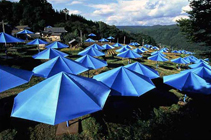
Umbrella project
An art work by Bulgaria-born Christo and his Morocco-born wife Jeanne-Claude. Gigantic blue umbrellas were installed in places such as paddy fields, hilltops and in the rivers. The project involved the residents of the various regions as well as the foreign ministry, politicians and the business world.
NagashimaI was in my second year at elementary school, so I must have been around seven. I'm from Ibaraki Prefecture. The works by Christo were on display all over the expanse of rice fields in Ibaraki. Until then, I had never seen a work of art, and seeing such a thing for the first time was shocking and left a lasting impression on me.
TsubakiI suppose that at first you didn't understand why these gigantic blue umbrellas were standing in the rice fields?
NagashimaNo, not at all.
TsubakiI think it's perfectly fine not to understand the meaning of such works. But the formative experiences of childhood do have a profound effect. Perhaps the shock you received then has something to do with the blue coat you are wearing today. (laughs)
I think it's wonderful to encounter a work of art that influences your actions without your knowing it. Creating a town of art is about placing hints in a town that have the potential of changing people's lives. I think it's good for a city to have that kind of function. Perhaps people who come to Roppongi will find hints to learn something deeply and their lives might change. I think the art installed in this area should be works which transcend time and which are universal; they should be artworks that people will be talking about from generation to generation.
NagashimaEncountering a really good work of art is like encountering a really good book. Your imagination is stimulated and you do a lot of wondering - speculating about the message behind it. When you make the effort to heighten your sensibilities and keep them pure, your reading capability is strengthened - you are able to perceive more things. Just like books, artworks each have a message, and I think they have a lot to offer to people.
TsubakiI do have not a good opinion at all of current state of the global art market. The art market itself is expanding and works are getting pricier, but does a piece of art move the viewer? Does the work keep having an effect on the viewer after the initial encounter? These questions do not have anything to do with whether the work sells or does not sell. Yet despite this fact, famous works are now virtually the same as stocks and bonds. Many are bought up for their resale value. That's why the works sell now are only those by famous artists or small pieces by young artists which can be bought for around 50,000-100,000 yen. The works by mid-career artists or artists who are now entering the most important phase of their lives do not sell any more; the market for these people has collapsed.
With the art market in such a lopsided state, it's very difficult to create a situation where people can encounter artworks that will stand the test of time. I'm sorry if I sound pessimistic...
I also think that people should have a little more humility when appreciating art. I don't think people should go out to see artworks in the hope that the works will give them something. There are people who say they don't understand art, but such people are often those who haven't made an effort to understand. In order to be enriched by art, viewers need to be responsible for preparing themselves.
There's a documentary movie called "Herb and Dorothy" which I think everyone should see. It's about a contemporary art collection accumulated by an elderly man and his wife. The man used to sort mail for the postal service, and the couple bought the works with their modest salary. Among the works they collected are things that look like an iron plate and nothing more. The values of the works were unknown and yet they had the courage to buy them, and they poured their passion into them. I really hope people will watch this movie.
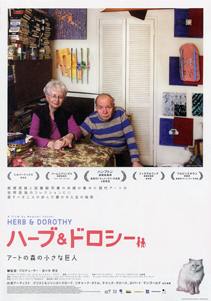
Herb and Dorothy
©2012 Fine Line Media,Inc.All Rights Reserved.A place with an archive where people can study
TsubakiNow I have finally reached the point of talking about my proposal for Roppongi. Nagashima-san, you say you would build a forest. Well, in that forest, I would build a little school. For people to have the ability to appreciate art -which we talked about earlier - we need education. We need to properly educate people so that they can properly look at art.
A large university would be no good. We need to have a small art school, which doesn't fit in with the established art system and other conventional systems. I envision a botanical garden with a café. Everyday in the café, there will be a person from the frontline of the art world who will give people a lecture on art. There will also be a good library filled with carefully selected books. The number of books may be small, but they will be "must-reads" on architecture and so on. It will be a place where people can leisurely read books and browse the archives.
Nagashima It sounds very good indeed.
TsubakiIn Japan, works are just displayed without archives. There are no materials showing the history of the work. We need a design museum in Japan like the Museum of Modern Art (in New York) where people can learn about the history of design. I think it's insulting that there are no places with archives that allow you to see how a piece of work was made.
Plenty of events are held in Japan, but there are no places where people can study. Art is not about giving a fleeting glance at works. You need to study it, and when your understanding deepens, you become like Herb and Dorothy. This town lacks the means where everyone can go through the process of becoming like Herb and Dorothy.
デザインイベント2012・レポート
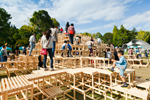
<Tokyo Midtown DESIGN TOUCH 2012>
Tokyo Midtown DESIGN TOUCH is in its 6th year. With the theme "Play with Design", many works which we can enjoy by touching them were displayed and placed throughout Tokyo Midtown.
Official website
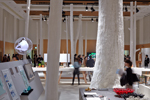
<DESIGNTIDE TOKYO 2012>
We can encounter wide ranging of design works including interior and product materials. This event, attracting much media attention, provides designers with opportunities to display and present their works to the World.
Official website

<Tokyo Midtown Award 2012>
This award is held to discover and support artists and designers of next generation. 14 art and design works were awarded out of 1,381 submissions. The award-winning works are showcased from Oct. 26 to Nov. 25.
Official website

Things that encourage people to think
NagashimaTsubaki-san, you just mentioned the word "insulting" and that reminded me how that also describes the mass-production oriented world of design in some ways. There's this "copy and paste" mentality - the notion that things which can be quickly produced are good. There seem to be too many products which excessively pursue convenience and comfort. For example, I think it's weird that the lid of a toilet seat should automatically go up when you go near it.
TsubakiAn automatic toilet lid.
NagashimaYes, the lid opens up by itself. When that happens, I go "No, no, no! I can lift it myself, thank you." I think that's excessive. It's almost insulting, and I feel it's something that weakens the abilities of the user. I have to admit though, that it is the responsibility of designers to become more sophisticated and to raise their standards in design.
TsubakiI agree. I think it's the responsibility of designers and artists to prompt people to think. Our brains want to make as little effort as possible, so when things become the daily routine, we stop to think about them. I mean, daily life would become too complicated if each time we touched the door knob, we pondered whether the shape of the knob was okay or not. But when we look at works of art and design, we need to have the ability to think for ourselves - to not be swayed, but to have our own personal viewpoints. When devices become automatic, our abilities are gradually eroded and that eventually leads to us becoming weaker human beings.
NagashimaIn the little school in the forest that I envision, I would love to do things that are somewhat primitive, which help to foster our capabilities as humans.
TsubakiHow about having a course on bonfires and wall paintings? Everyone participates in the course almost naked, wearing only small pieces of cloth. We start by learning about the Chauvet Cave paintings made 32,000 years ago which are said to be man's oldest paintings.

Chauvet Cave
A cave in the Ardèche department of southern France. There are various theories, but one theory has it that the paintings in the cave are 32,000 years old, making them the most ancient existing paintings by man. The paintings have apparently been drawn employing techniques such as stamping and spraying black pigment.
NagashimaOh, so we start from there. (laughs) I do think it's significant to think about creating formative experiences though. The difficult thing is how to teach design in that context but I suppose we could teach things like how water is boiled. Today, water is boiled automatically, but heating water used to require labor. In the old days, people had to first cut down the trees, chop the firewood and make the fire, and so on. There were all these chores; the lifestyle we have today is thanks to the innovation that has taken place since those days. It would be good if we could let people get a taste of that initial, primitive experience.
The decrease in physical activities is eroding creativity
TsubakiAt the university I currently teach at, we had a series of accidents involving electric tools. Students in their second year and third year injured their fingers with these tools, even though they were familiar with them. The accidents made us think that we should change the whole curriculum. We thought it would be better to have students in their first year start by making knives. So we are now thinking of inviting a bladesmith come and teach the students how to temper steel. Ideally, in about six months, they will be able to make a proper knife. They will learn how to meld the soft steel and iron steel, use the fuigo (Japanese box bellow), burn them on coal and sharpen the knife with a whetstone. By starting with that experience, I think students will be able to predict the movement of blades.
While learning to make one knife, they will be dealing with steel and fire, and getting in touch with most elemental things for humans. By using with them, they will be able to predict things better; they might sense that something is wrong with a knife and that it might be dangerous, or they might be able to look at the rust on a knife and tell how much cutting edge the knife still has.
NagashimaAll of this would be a formative experience - things which we have so far overlooked. I think it's definitely important to teach the basics. Instead of simply giving children hot water, we should give them the experience of seeing how the temperature of water can go up or down.
TsubakiI have a passion for flying kites. Even with a cheap kite that costs about 500 yen, I can fly it really high. By making the string about three times longer, I can fly a kite so high that it's no longer visible. The other day, I was flying a kite with a friend and I noticed that my friend was running in the same direction as the wind. You need to go against the wind to fly a kite. I felt that my friend's inability to predict the movement of the kite showed a deteriorating ability to sense the wind. It was driven home to me that if you don't have the formative experience of knowing how things function, your ability to use things will weaken.
In homes in the cities, it's not easy to give education to children through formative experiences. So the ideal is to have a little school in the forest with a workshop where children can learn things like how to use a knife. These things would be taught by the kind of men who work at a Tokyo Hands store. We would have to ask the parents to sign a memo saying they will not complain if their children chop their fingers off. Complaining parents would be a problem - these days, those issues have become very tough.
The activities of design and art originally took place in the home, but they have almost disappeared now. The one thing that parents still do is to read a picture book aloud to their children. But there are less physical activities such as going to the sandpit and climbing trees. There are many fantasy stories being made, but not enough of physical activities being carried out. I think this has led to an imbalanced environment, and has eroded the creativity of Japan.
Avoiding the summarized life
NagashimaI think that if the convenient functions of the society keep on being enhanced, people are going to become very lazy. They won't need to create things or even move. Just by pushing a button they can get somewhere. It's becoming so extreme. Also, I think people make too much of a distinction between the city and the countryside. It seems to be either this or that, but I think it could be a bit of both. We should affirm the positive aspects of both the city and the countryside and try to strike a good balance.
In the old days, in the countryside, the dead were buried in the ground. When my grandmother and grandfather died, their bodies were placed in the ground and a mound of earth was formed where they lay. And when the ground became flattened, I felt that they had really had become part of the earth.
TsubakiThere must have been a stark kind of reality in that.
NagashimaYes. Bodies are cremated now. I feel that cremation seems to somewhat take out the reality of death. It's almost like summarizing and shortening the phenomenon of death. I feel that cremation seems to pass over the important parts and is sort of extreme, like a lot of other things.
TsubakiIndeed, "summarize" seems to be the key word here. People seem to be living lives that are summarized. It would be fine if it's their choice, but I think it's awful if they are unknowingly being forced to live summarized, shortened lives. You were talking about how the countryside and the city are not things on opposite ends of the spectrum. Things like that cannot be summarized because they're too complex. It would be wonderful if there was a place in Roppongi where people could talk at length about blending dual aspects without summarizing and shortening things.

A nondescript town that has a lot of things
Nagashima If you were to ask me which my favorite town is, it would be my hometown. It's in the remote countryside in Ibaraki Prefecture. I lived there till I was a high school student. There are no street lights and only about two traffic lights. On the car navigation system, it appears as only one strip. (laughs) I live in Tokyo now, but I think I perceived everything I needed to perceive in that town. I feel afraid of forgetting the way I perceived things when I lived with my family there. It seems to be a town that has nothing, but it actually has a lot of things.
For example, it's frightening walking in the dark, isn't it? But on nights when the moon is bright, you can see your own shadow and you don't feel frightened at all. In the city, you forget these things, but when you're in the countryside, your physical senses are sharpened, and you also become sensitive to the change of seasons. You can more easily sense the humidity, the smell, the wind and the sounds. You can feel that you are a little scrap of this earth - just a little part of nature. I think it's good that there are places which make you feel that way on a daily basis.
TsubakiI've been to many foreign countries, and the country that is most memorable to me is America. I went there for my first international exhibition, and being clueless, I stayed the night in a slum. Then my friend and I decided to go to Mexico, and we got on a shabby Honda to drive to Mexico. We had to turn back halfway through the trip for a certain reason, but it was great driving along the shoreline of an empty wilderness, playing Mexican music on a cassette tape of and singing along. It was just supreme. That experience is a memory I will recall when I am dying.
Also, around the year 2008, I went to Colorado where a friend of mine lives, in order to take photographs for a large exhibition in Kyoto. My friend told me to come from Las Vegas, so I rented a car in Las Vegas, and headed to Colorado; it was my first ever experience of driving through the American continent. I'm impressed with myself for doing such a reckless thing at my age, but anyway, I managed to drive through Las Vegas and when I finally reached the single road, I felt so exhilarated. I was the only person driving along this one road on the empty American continent, with the sun setting on the basin-like landscape.
And I shouted to myself, "Too late!" I felt that I should have done this when I was younger. It was too late in my life to be driving a rented Hyundai! So I really recommend young people to drive solo across the American continent. It's a totally different world. You find yourself in the middle of the Nevada Desert with a sign saying that the next gasoline stand is 200 kilometers ahead. Without a full tank you feel that you might end up a corpse somewhere. I think though, that the experience of being isolated in nature is something that you will always recall for the rest of your life. I feel a bit embarrassed [about my reckless trip] but I must say that such adventures are good.

Tsubaki Noboru 2004-2009:GOLD/WHITE/BLACK
An exhibition by Tsubaki Noboru held at the National Museum of Modern Art, Kyoto in 2009. The exhibition was comprised of many striking artworks throwing a question to a current relationship between art and society. Works included pictures of former mine sites and documentary films of ritual ceremony of sacrifice of different cultures from all over the world.
NagashimaI've talked to students lately and they tell me that they don't travel overseas that much. But one single experience or an encounter with one person- even if only for a brief moment- can have a lasting effect.
TsubakiA special experience gives you a special energy and it lasts for a very long time. You may only have one small engine but you can use it every time. I myself feel as if I've always continued on just one little engine. To be engaged in art and design, you need to have that "original foundation" within you - like a reservoir of energy that you can draw from whenever necessary.
It's not necessarily good to use design to make things neat
NagashimaI think the "original foundation" for me would be the view I saw from an airplane. About three or four years after I started working, I went to Ayers Rock in Australia from Sydney. Being a city, Sydney was a place of straight lines, but as the plane moved farther away, the straight lines disappeared one by one. And at the same time, curvy lines kept increasing, and all kinds of colors began to appear and I began to see a chaotic landscape.
After spending a few days in Ayers Rock, I went back to the capital, and naturally this time, the landscape from the airplane changed in the opposite way. One by one, straight lines began to appear among the wavy lines, and I could see how things were being neatened up. Looking at that, I suddenly felt frightened of being neatened up. I thought, "I am a human being and a living creature, and I originally had those wavy lines within me. They can't neaten me up systematically like that by adding those straight lines one by one." That was quite an intense experience that left an impression on me. It was then that I thought it's not necessarily good to use design to make things neat.
I think design has two aspects. One is to serve a function for everyday life. That aspect is absolutely vital. The other aspect is to satisfy the personal sense of beauty. A dress should not just be something to keep a person warm; it should be something that is desirable for the wearer. The wearer might say, "It's weird but I like it." I think designs are about those very human emotions.
Giving form to things that used to be invisible
NagashimaIn my work, what interests me most now is providing something which is at "midpoint." I want to design something that has elements of both the countryside and the city. I'm not sure what exactly it will be - it could be clothing or food. Designs enable you to express your view of the world and I would like to show a "midpoint" world which combines the best of both worlds. There might be people who have been waiting for that kind of midpoint world to appear.
TsubakiSo you want to give form to something that is currently invisible. When we look at the stars in the sky, we identify the constellations and say, "That's the Orion", but if we had no preconceived knowledge, we would gaze at the heavens and connect the stars in our own way. We would design our own constellations. The work that you are doing now, Nagashima-san, is similar to designing a new constellation. I think people are waiting for you to connect the stars in a different way from before. And the instant that design becomes visible, the targeted audience, the people, and their driving power become visible too. Unlike art, design involves the designing of systems; it has mighty potential.
NagashimaWhat interests you most, Tsubaki-san?
TsubakiIn my case it would be education. The students entering Japanese art universities now have fallen to a sixth of peak levels; the drop has been so dramatic. The weak economy is the biggest factor, but the there are many other factors including the view that an art graduate won't be able to get a job. The fact is however, there are many roles for art in today's society. The art I'm talking about is more like "community design". I know of a case where a woman in Tokyo who graduated from an art university went to the countryside and helped transform a town. There are many other similar examples.
The biggest strength of art students lies in their ability to actually get work done in a place and also in their ability to create things. They have the skills to communicate and to give form to expression. Graduates with degrees in economics or law don't have their level of skills. People who have graduated from art universities can draw their own illustrations, make advertising materials for the town hall, or even build a website. If a pretty girl went along to the town office and proposed a design she has in mind, the men are likely to promptly say yes. (laughs)
In that respect, I think art students, particularly female art students, have a great deal of potential to create new designs for Japanese regions. But every year, the number of students entering art universities is falling by about 10%, so I suppose that people are not fully aware of that potential. Perhaps there are not enough role models like you, Nagashima-san. Maybe we shouldn't use the words "art" or "design" but declare that the schools will "mass-produce Rikako Nagashima-san". Maybe we should have a new department called "Department for mass-producing Rikako Nagashima."
NagashimaThat sounds frightening. (laughs)
TsubakiNo, I think it's a good idea. From now on, competent people who have studied design and art should be going to the countryside. Aside from making my own artworks, I'm putting a lot of energy now into sending out the message that there are lots of opportunities in the regions.
Editor's thoughts
The thought-provoking interviews with creators are usually held in the meeting rooms, but this time, we held the interview in front of the public on the final day of the DESIGNTOUCH event. Nagashima-san proposed building a forest in Roppongi and Tsubaki-san said he would build an art school in that forest. The way the art director and artist put forth their ideas seemed to reflect their various professions, and it was intriguing listening to them. Incidentally, I had not seen "Herb and Dorothy" and instantly took steps to see it.




